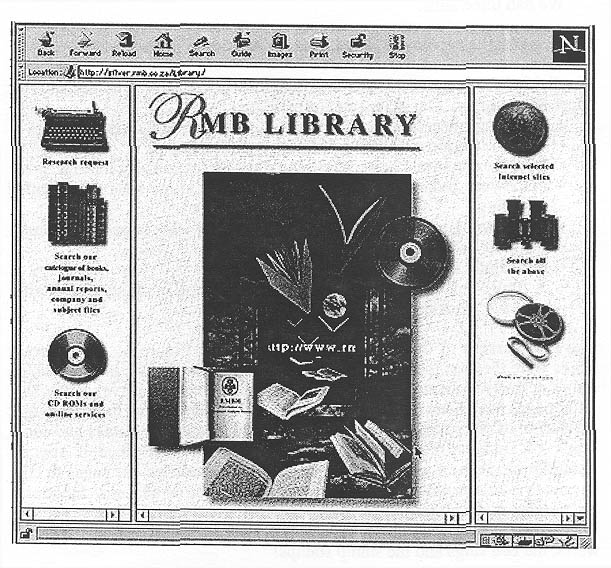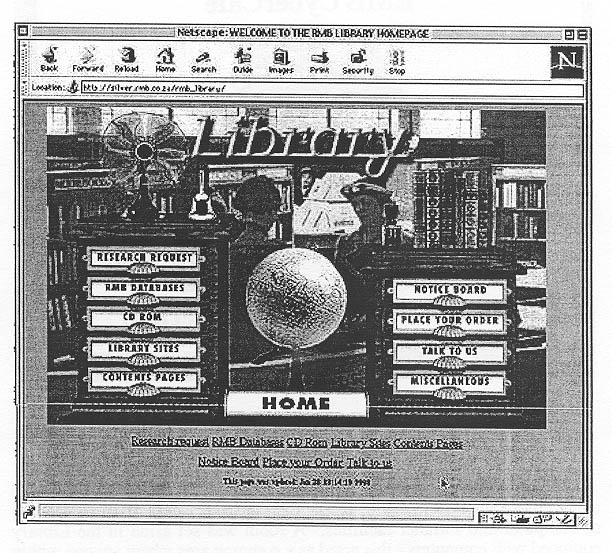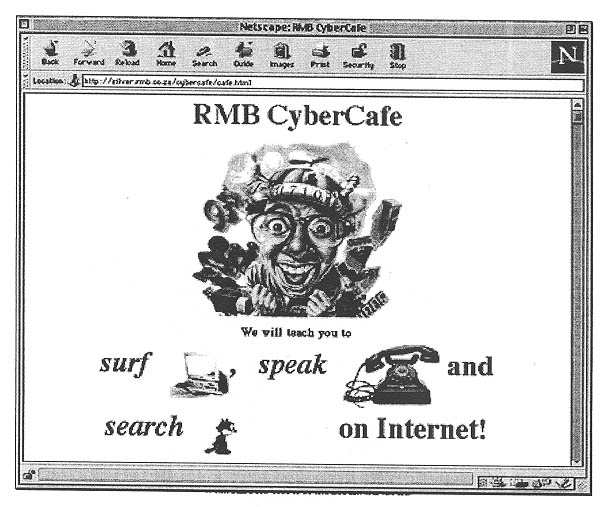
Diana Kruger
Caroline de Wet
Rand Merchant Bank
Sandton, South Africa
E-mail: dik@rmbmain.rmb.co.za
E-mail: cdw@rmb.co.za
This paper describes how Rand Merchant Bank implement Internet and Intranet to steer its libraries into the fast lane of the information superhighway of the twenty-first Century.

Sometimes it takes a great idea to change the world. Sometimes it takes two. That's the case with Intranet technology, a major advance in corporate computing based on two great ideas: From the former, "Intranets inherit the proven, cost-effective technologies of the global Internet. From the Web, Intranets inherit the hyper-text linking of documents across boundaries" (Benett, 1996).
In this paper we will briefly discuss:
• Elephants and Organisations.
• Libraries - and thoughts on empowerment
• How we made an Intranet work for us - the Rand
Merchant Bank example
In this section, we shall discuss the following:
• Intranet Use
• How do Intranets Work?
• Security on an Intranet
• Why this success?
We will not discuss the Internet in depth since there is already a plethora of conference, papers, books, and web sites to explain it. Much of the real action in uses of Internet tools is occurring in applications that remain behind corporate walls. Our focus will be a shift away from Internets and external communication to the internal web application of networks within the "elephant" or organisation - the Intranet. Netscape reports that more than half of its web server sales are earmarked for corporate Intranet use. Predictions of Intranet growth state that by the turn of the century - only four years away - Intranet servers will outsell Internet servers 4.6 million to 440,000. Zona Research, a market research company, estimates that $2.67 billion was spent on corporate intranets in 1996, and that by 1999 investments could rise to over $13 billion.
Thus, Intranet adoption becomes pervasive, as shown
in Figure 1. Intranets are redefining corporate communication systems and
changing the basic ways in which people work.

Source: Business Research Group.
(This was originally a colored charge -- the line on top is for "Internet",
while the longer line in the bottom is for "Intranet")
WHAT IS AN INTRANET?
While the Internet defines the technology available for external communications, an Intranet refers to the application of these technologies within an organisation, centered around the corporate LAN. On the face of it it's a great idea to take technology designed to be robust and used world-wide and adopt it for corporate use (Miller, 1996.)
Unlike traditional LANs, which use platform specific, client/server technology to run, and distribute and view applications, an Intranet can work seamlessly across all platforms. Given the benefit of the WWW browser interface, it also makes it much easier to distribute and access information - including multimedia documents.
An Intranet puts slick and seductive web technology to work inside an organisation to do real everyday work, using web browsers to perform regular day to day activities, and making information corporate-wide within seconds. And with web browsers comes the fun bit - hypertext documents with hyperlinks including:
• multimedia technology,
• following your interest by just the click of a button, and
• all this is available and accessible to even novice computer users.
Currently, there are three major uses:
2. Collaboration - email, newsgroups, and from there threads can go virtually anywhere,
3. Distributed applications - employees can develop a report, analyze
data, learn or train without the frustration's of telephone tag or paper
pushing. The same information can be retrieved from multiple locations.
• Cost-effective - no printing/distribution costs,
• Easy to use - point and click,
• Versatile - presentation can include text, video, sound and graphics, and
• Value added - for example, a corporate diary that shows all leave applications allows for better planning and organisation.
At the heart of the Intranet is a server - a powerful computer used for storage of information that is accessible to all. As information changes the server content can be easily updated with the new or revised data - an approach that allows organizations to deliver timely, consistent and accurate information to their employees world-wide, without expensive typesetting, printing, distribution, or mailing charges, or a lot of telephone tagging.
Any user or department on the Intranet can interact with any other department or user and beyond, to partners, markets and other locations, creating and sharing a corporate knowledge base that acts as both a distribution and brainstorming device.
SECURITY ON AN INTRANET
Security on an Intranet is an important subject that needs to be mentioned. Data on an Intranet is vulnerable for many reasons including the following:
• Not all Intranets are internal. Large organizations may use them as a low cost wide area network to send company data between regions, cities and countries,
• There is a risk of accidental erasure or overwriting of documents, and
• When connected to the Internet, there is a risk of external people accessing (and possibly destroying) confidential internal corporate information.
• Encryption - transforming the data into a form unreadable by anyone without a secret key,
• Implementation of a firewall. This is a device that provides secure access and communications between an Intranet and the Internet.
WHY THIS SUCCESS?
Intranets let companies distribute information and software to employees and business partners quickly. They are inexpensive to develop, maintain and use. Sharing information leads to better informed employees, faster response times and a better relationship with customers (Miller, 1996). Businesses that have networked computers already have the basics in place. Internet technology, compared to proprietary networking environments, is surprisingly low in cost. The only initial expense is to have someone write the descriptive 'web' pages and links - options offered in most word processing programs and other productively software applications.
SATISFACTION LEVELS OF INTRANET INVESTMENT:
How Corporations Rate Their Intranets
Driven by a powerful combination of openness and security, access to detailed information, extreme cost-effectiveness and flexibility for customization in an increasing competitive times, the Intranet produces a transparency of corporate information previously unknown. This does not only result in technological change, there will also be a cultural change within the organisation as the influence of easily accessible information is felt across the enterprise as a whole.
This change can have radical implications for the role of libraries and librarians. The installation of an Intranet (and the use of the Internet) can either lead to the side-lining or possible bypassing of the library or can be used by the librarian as an opportunity to lead the way and be seen as the guide through this information maze.
Figure 2 shows the results from a Computer Intelligence survey. It seems to suggest that Intranet enjoys high levels of user satisfaction with 28% each indicated "very satisfied" and "satisfied", and 37% indicated "usually satisfied". Only a small 6% indicated lukewarm "somewhat satisfied."

Source: Computer Intelligence.
3. ELEPHANTS
Talking of Elephants, we need to discuss how to teach the elephant to dance, and the need for corporate strategy.
TEACH THE ELEPHANT TO DANCE
Intranets of course need "elephants", or organizations in order to exist. Organizations are like elephants - they both learn through conditioning. Belasco in his book entitle Teach the Elephant how to Dance uses an image of how elephants are conditioned to demonstrate change in organizations.
Trainers shackle young elephants with heavy chains to deeply embedded stakes. In this way the young elephant learns to stay in its place. Older elephants never try to leave - even though they have the strength to pull the stake and move beyond. Their conditioning limits their movements with only a small metal bracelet around their foot which may be attached to nothing.
The image of this elephant is also a good synonym for large organizations. Like powerful elephants, many companies are bound by earlier, conditioned constraints. "We've always done it this way" is as limiting to an organization's progress as is the unattached chain around the elephant's foot.
However success ties one to the past. The very factors that produced today's success often create tomorrow's failure. Change is essential for survival. The following quotes should be of interest to us:
• "It is not the strongest of the species that survive, nor the most intelligent, but the one most responsive to change" - Charles Darwin
THE NEED FOR A CORPORATE STRATEGY
Five things are needed for the right strategic direction for the development of a corporate Intranet:
• Vision,
• New strategies,
• Key people, and
• Focused resources.
After leadership and vision comes action. When planning an Intranet the need for pre Intranet chat and brainstorming is really important. What do you want the Intranet to do for you? Be prepared for constant change - as your Intranet takes shape new applications will develop as the ease of the use of the technology and the many ways in which it can save administrative time becomes apparent.
Be innovative but stick to standards, beware of fads (plug-ins) that may disappear in a month or two.
4. LIBRARIES
LIBRARIES AND THOUGHTS ON EMPOWERMENT INTRANETS TO LIBRARIANS
The librarians and information professionals can empower themselves and their departments by implementing change and by introducing an Intranet to their elephants.
The Library should be the heart of corporate communication - the hub of information distribution, the natural starting place for an Intranet!
For years librarians have wanted to push the walls of the library down and open it up to more use, more users, and greater realization of its potential value. Finally, aided by network technology, we're succeeding. However, we're being met on the other side... and not only by users willing to accept our tried and true ways of providing information to them. New and experienced users are willing and anxious to become collaborators or competitors-in the information arena.
Empowered users aren't the only players. On a web page entitled "Cyberstats"
(http://www8.zdnet.com/zdimag/cyberstats/1997/10/index.html), the following levels of involvement in Intranet implementation were noted:
• 59% MIS Director/Network Manager
• 46% CIO/VP of Information Systems
• 34% Other department manager
• 17% CEO or President
Where are the librarians? Perhaps part of the 34% of "other department managers?" Librarians must work, in partnership and in competition, with multiple constituencies -- customers, management, Information Services staff, and vendors. We and these other players have a lot to learn as we maneuver around organizations that are themselves struggling to survive as business environments change radically. There are many additional players in what has become a very serious and important game - the game of selecting, organizing, managing, and marketing information resources-both internal and external-throughout the organization. It goes far beyond the positioning of a "library" in an organization; it is crucial to the survival of most businesses and institutions in a new, global, knowledge-based economy.
We have important and unique skills to bring up to the playing field. The skills of a librarian are not dead. They are more important than ever. We just need to apply them in a different, faster-paced, more populated environment than ever before.
As mentioned earlier, leadership and vision are essential for an effective corporate strategy. Action is the next step. Its not so much what you know that matters, but what you do with what you know.
Talk to the right people and discuss how all of you can use this vision to accomplish new strategies for corporate communication and in this way you remove that bracelet from your organization's feet - set your elephant free!
5. HOW AN INTRANET WORKS FOR US - THE RAND MERCHANT BANK EXAMPLE
As a brand new library starting from scratch, we undertook a needs analysis to find out what our users really wanted. Our vision and mission was to be a truly electronic library. That meant accessible by all, all the time, from anywhere - and that spelt INTRANET
We had three aims:
1). To make the resources of the Library available to all
We divided the identified needs into major areas and structured our Intranet pages accordingly. Our main categories were:
• Research requests (email within the organisation)
• Links to electronic newspapers and journals (essentially Internet sites)
• Place your order - a way for people to let us know what they wanted us to buy
• Corporate databases (accessing and searching other departments stuff)
• "Talk to Us" - for feedback and chat
• New Book Lists
• A future development may be to scan in journal contents pages- after we have wrestled with the copyright issues!
Our new page, soon to be released will look like this Figure 4. The fan whirs, the bell rings and the stamp stamps!
2). To promote Internet literacy through use of the Intranet
We actively set out to train people in the effective use of Intranet, thus establishing ourselves as the "experts". Our aim was to train people in the use of the Intranet/Internet and thus make the library the hub of the Bank for Intranet/Internet access and communication - this led to the formation of our CyberCafe (Figure 5).

Figure 3. The first version of our Intranet page

Figure 4. The latest version of our Intranet page

Figure 5. CyberCafe Page
Although the Bank was committed to the creation of an electronic communications system, some people did not have access or understanding of computer and Intranet facilities. A room was set aside in the Library equipped with computers - this acted as a common area where anyone within the Bank could come to "speak", "surf" or "search" the Net. We designed a "Teach yourself the Internet" tutorial and are busy setting up training sessions - the focus is to make the Internet fun as well as showing all the advantages of access to information. These training sessions will run during lunch times and while fulfilling both a training and educational purpose, they are also playing an important marketing role - the Library is being kept in the public eye.
3). To provide access to specialized electronic equipment
The Cybercafe also hosts a scanner and a collection of clip art and CD-ROM's. For people with limited equipment on their desktops, the multimedia computers allow access to information previously inaccessible.
Finally, Intranet technology is fast becoming such an integrated part of our normal working day that, like the fax machine, we will wonder how we coped without it. It has certainly changed the image and accessibility of our library. Changing an organisation can be very slow and cumbersome but the introduction of an Intranet can radically improve work flow systems and communication. By being a constructive force for the change and a major player in the team when designing and implementing this change a librarian can bring about tremendous and surprising empowerment for both themselves and their department. Seize the initiative, work closely with your Information Technology department and show your elephant the way to achieve employee empowerment and efficiency by allowing them easy access to information that will help them make the right decisions at the right time in the easiest way possible.
REFERENCES
Alert: News and views for M.A.I.D clients. No.6, July/August 1996.
Amoroso, Edward and Sharp, Ronald. (1996). PCWeek: Intranet and Internet Firewall Strategies. Ziff-Davis Press.
Belasco, James A. (1992). Teaching the Elephant to Dance: Empowering Change in Your Organisation. London: Century Business.
Benett, Gordon. (1996). Introducing Intranets: A Decision Maker's Guide to Launching an Intranet. Que Corporation.
Bickel, Robert. (1996, March). "Building Intranets: Internet webs give companies a new solution to an old problem," Internet World.
"CD-ROM and Web Browsers: HTML as the Lingua Franca," CD-ROM Professional, August 1996.
Cyberstats (http://www8.zdnet.com/zdimag/cyberstats/1997/10/index.html)
Evans, Tim. (1996). Building an Intranet. Sams.net.
Herther, Nancy. (1998, January/February). "The Personal Computer: Today's workhorse moves into the 21st century," Online.
Internal Webs as Corporate Information Systems.
(http://home.netscape.com/comprod/at_work/white_paper/indepth.html)
Intranet - a Guide to "Intraprise-Wide" Computing.
http ://www.process.com/news/intrawp.htm
The Intranet: A corporate revolution.
http://www.intranet.co.uk/intranet/intranet.html
Miller, Michael J. (1996, March). "Your own private Internet," PC Magazine.
Ozer, Jan. (1996, August). "Totally streaming multimedia: CD ROM publishers and problems on the World Wide Web," CD-ROM Professional.
Paxton, Brian and Baker, Trish. (1996, Sept. 19). "Strategic advantage: Planning and strategy seminar," Business Day Wired World Conference.
Sper, Brandon. (1996, September 19). "Intranets: How to make them work for you seminar," Business Day Wired World ConferencE.
Strom, David. Creating private Intranets: Challenges and Prospects for IS: A white paper for Attachmate Corp.
http://www.strom.com/pubwork/intrenetp.html